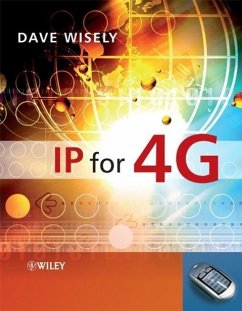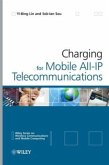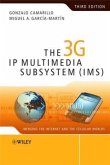David Wisely
IP for 4G
David Wisely
IP for 4G
- Gebundenes Buch
- Merkliste
- Auf die Merkliste
- Bewerten Bewerten
- Teilen
- Produkt teilen
- Produkterinnerung
- Produkterinnerung
This book provides an essential summary of the key technologies and issues of 4G. It brings together the technology, the commercial arguments and the latest developments in a single volume. It assesses the key technological drivers of 4G (wLAN (wireless Local Area Networks), WiMax (Worldwide Interoperability for Microwave Acces), convergence, and IMS (IP Multimedia Subsystem), leaving the reader with a very clear and up-to-date briefing on the future of Mobile in the next 2-5 years. The book looks at developments globally and not specifically be UK or Europe with case studies on companies such…mehr
Andere Kunden interessierten sich auch für
![Design, Deployment and Performance of 4G-LTE Networks Design, Deployment and Performance of 4G-LTE Networks]() Ayman ElNasharDesign, Deployment and Performance of 4G-LTE Networks113,99 €
Ayman ElNasharDesign, Deployment and Performance of 4G-LTE Networks113,99 €![3G, 4G and Beyond 3G, 4G and Beyond]() Martin Sauter3G, 4G and Beyond106,99 €
Martin Sauter3G, 4G and Beyond106,99 €![Lte and the Evolution to 4g Wireless Lte and the Evolution to 4g Wireless]() Agilent TechnologiesLte and the Evolution to 4g Wireless133,99 €
Agilent TechnologiesLte and the Evolution to 4g Wireless133,99 €![Broadband Packet Switching Technologies Broadband Packet Switching Technologies]() H. Jonathan ChaoBroadband Packet Switching Technologies187,99 €
H. Jonathan ChaoBroadband Packet Switching Technologies187,99 €![Charging for Mobile All-IP Telecommunications Charging for Mobile All-IP Telecommunications]() Yi-Bing LinCharging for Mobile All-IP Telecommunications134,99 €
Yi-Bing LinCharging for Mobile All-IP Telecommunications134,99 €![The 3g IP Multimedia Subsystem (Ims) The 3g IP Multimedia Subsystem (Ims)]() Gonzalo CamarilloThe 3g IP Multimedia Subsystem (Ims)130,99 €
Gonzalo CamarilloThe 3g IP Multimedia Subsystem (Ims)130,99 €![Towards 4G Technologies Towards 4G Technologies]() Hendrik Berndt (Hrsg.)Towards 4G Technologies144,99 €
Hendrik Berndt (Hrsg.)Towards 4G Technologies144,99 €-
-
-
This book provides an essential summary of the key technologies and issues of 4G. It brings together the technology, the commercial arguments and the latest developments in a single volume. It assesses the key technological drivers of 4G (wLAN (wireless Local Area Networks), WiMax (Worldwide Interoperability for Microwave Acces), convergence, and IMS (IP Multimedia Subsystem), leaving the reader with a very clear and up-to-date briefing on the future of Mobile in the next 2-5 years. The book looks at developments globally and not specifically be UK or Europe with case studies on companies such as BT Fusion, Swisscomm Convergence, Virgin Quad Play, WiMax trials, and a website with diagrams and figures as well as references for further reading.
Hinweis: Dieser Artikel kann nur an eine deutsche Lieferadresse ausgeliefert werden.
Hinweis: Dieser Artikel kann nur an eine deutsche Lieferadresse ausgeliefert werden.
Produktdetails
- Produktdetails
- Verlag: Wiley & Sons
- 1. Auflage
- Seitenzahl: 314
- Erscheinungstermin: 1. April 2009
- Englisch
- Abmessung: 239mm x 193mm x 23mm
- Gewicht: 826g
- ISBN-13: 9780470510162
- ISBN-10: 0470510161
- Artikelnr.: 23501053
- Herstellerkennzeichnung
- Libri GmbH
- Europaallee 1
- 36244 Bad Hersfeld
- gpsr@libri.de
- Verlag: Wiley & Sons
- 1. Auflage
- Seitenzahl: 314
- Erscheinungstermin: 1. April 2009
- Englisch
- Abmessung: 239mm x 193mm x 23mm
- Gewicht: 826g
- ISBN-13: 9780470510162
- ISBN-10: 0470510161
- Artikelnr.: 23501053
- Herstellerkennzeichnung
- Libri GmbH
- Europaallee 1
- 36244 Bad Hersfeld
- gpsr@libri.de
Dr. Wisely has worked for BT for 20 years in the fields of networks and mobility research. He pioneered optical wireless links in the early 1990s constructing a 4 km, 1500nm system using optical amplifiers. Dave has worked in the field of mobility for the past 10 years, looking firstly at wireless ATM and HIPERLAN systems and more latterly into the combination of cellular mobile and WLAN systems. Dave was one of the pioneers of an all-IP solution for future developments of 3G. He also acted as technical manger for the influential EU IST BRAIN/ MIND EU IST project which did much to push forward with all-IP network concepts. He has contributed over 100 papers to journals and conferences, published one previous book and contributed chapters to over a dozen others. Dave was also the co-editor of the BTTJ special edition of mobility. He is currently in charge of all convergence research and development at BT and has responsibility for BT's twenty-first century network's convergence research programme. Dave is married with two children aged 11 and 8 and lives in rural Suffolk. His hobbies include: cricket, tram-spotting and complaining about the transport system in the UK.
About the Author ix
Preface xi
Acknowledgements .xiii
List of Abbreviations xv
Chapter 1 Introduction 1
1.1 Prologue - The Generation Game 3
1.2 The Props - WLAN, WiMAX and All That 4
1.3 The Players - The Jester, the Harlequin and the Guy with the Beard and
Sandals 7
1.4 The Plot - The Elephant in the Room 9
1.5 Epilogue - The Road to 4G 12
References 14
More to Explore14
Chapter 2 An Introduction to 3G Networks 15
2.1 Introduction 15
2.2 Mobile Standards 16
2.2.1 Who's Who in Mobile Standards 16
2.3 The History of 3G 18
2.3.1 Pre-1996 - The Research Trimester 18
2.3.2 1996-1998 - The IMT 2000 Trimester 21
2.3.3 1998 Onwards - The Standardisation Trimester 23
2.3.4 3G Spectrum - the ''Fuel'' of Mobile Systems 23
2.4 UMTS Network Overview 27
2.5 UMTS Network Details 31
2.5.1 UMTS Architecture - Introducing the Major Network Elements and their
Relationships 32
2.5.2 UMTS Security 34
2.5.3 UMTS Communication Management 37
2.5.3.1 Connection Management 37
2.5.3.2 Session Management 37
2.5.4 UMTS QoS 40
2.5.5 UMTS Mobility Management 43
2.5.6 UMTS Core Network Transport 44
2.5.7 Signalling in the UMTS Core Network 47
2.6 UMTS Radio Access Network (UTRAN) and Air Interface 48
2.6.1 The W-CDMA Air Interface and the Uu Interface 48
2.6.2 UTRAN Mobility Management 51
2.6.2.1 Soft Handover 51
2.6.2.2 Handover Types 52
2.6.3 UTRAN Transport 54
2.6.4 UTRAN QoS 55
2.6.5 UTRAN Signalling 57
2.7 CDMA2000 Packet Core Network 58
2.8 TD-SCDMA 61
2.9 Conclusion 62
References 62
More to Explore 63
Chapter 3 Wireless LANs 65
3.1 Introduction 65
3.2 Applications of WLANs 66
3.3 WLAN Compared to Cellular 70
3.4 How WLANs Work 72
3.4.1 MAC Layer 73
3.4.2 WLANs - History and the Physical (PHY) Layer and IEEE 802.11 Groups
81
3.5 Performance of WLANs 84
3.6 WLAN Network Coverage 86
3.7 Improving WLANs 88
3.8 Security 89
3.9 Roaming 93
3.10 Quality of Service (QoS) 95
3.11 Handover and Paging 101
3.12 Battery Life 104
3.13 Go Faster WLAN - 802.11n 105
3.14 Interference 107
3.15 Future of WLANs 110
References 113
More to Explore 113
Chapter 4 Cellular Evolution 115
4.1 Introduction 115
4.2 What is Wrong with 3G? 116
4.3 HSPA 120
4.3.1 HSDPA Basic Principles 120
4.3.2 Channels in HSDPA 125
4.3.3 Handover in HSDPA 128
4.3.4 QoS in HSDPA 128
4.3.5 Terminals, Capabilities and Enhancements 132
4.3.6 HSDPA Data Rates 133
4.4 HSUPA 136
4.5 EDGE 140
4.6 EVDO and CDMA2000 Evolution 143
4.7 Femtocells 145
4.8 LTE 150
4.9 Conclusion 157
References 157
More to Explore 159
Chapter 5 WiMAX 161
5.1 Introduction 161
5.2 Overview of WiMAX History 163
5.3 OFDM 165
5.4 WiMAX MAC Layer 173
5.4.1 Downlink QoS and Scheduling 174
5.4.2 Handover 176
5.4.3 Security in WiMAX 177
5.4.4 ARQ and Forward Error Coding 178
5.4.5 Idle Mode and Power Saving 179
5.5 WiMAX PHY Layer 180
5.6 WiMAX QoS 183
5.7 Spectrum 186
5.8 Smart Antennas 188
5.9 WiMAX Network Architecture 195
5.10 WiMAX Throughput and Performance 197
5.11 Conclusion 200
References 201
More to Explore 202
Chapter 6 Convergence and the IMS 203
6.1 Introduction 203
6.2 The IMS 204
6.2.1 User Registration 209
6.2.1.1 Attachment to the IMS 209
6.2.1.2 IMS-level Registration 212
6.2.2 Basic IMS Session Set Up 216
6.2.2.1 The INVITE Message 216
6.2.3 IMS QoS Authorisation 219
6.2.4 IMS Service Creation 221
6.2.4.1 The SIP Application Server (AS) 221
6.2.4.2 Other types of Application Server 223
6.2.5 Presence 225
6.2.6 Push to Talk Over Cellular (PoC) 226
6.2.7 Roaming and Breakout to PSTN 228
6.2.7.1 IMS Roaming 228
6.2.7.2 Breakout to the PSTN 229
6.3 Convergence Today - Fusion 231
6.4 Voice Call Continuity 234
6.5 Media Independent Handover 237
6.6 Next Generation Networks 243
6.7 The IMS in Context Today 249
References 251
More to Explore 252
Chapter 7 Mobile Services - The Final Chapter 255
7.1 Introduction 255
7.2 Beyond Voice and SMS 256
7.3 Hard Lessons - MMS and WAP 258
7.4 Innovation - Mobile Music 261
7.5 Broadcast Services 262
7.5.1 DVB-H - Digital Video Broadcast-Handheld 263
7.5.2 DAB-IP - Digital Audio Broadcast-IP 264
7.5.3 MBMS - Multimedia Broadcast and Multicast Services 264
7.6 A New Paradigm - 1000 Killer Applications 265
7.7 Terminals 267
7.8 Money Makes the World Go Around 269
7.9 Mobile Broadband 274
7.10 Conclusion 275
7.10.1 Domination by the Mobile Operators 276
7.10.2 Converged World 276
7.10.3 Internet Scenario 277
7.10.4 Final Conclusion 278
References 279
Index 281
Preface xi
Acknowledgements .xiii
List of Abbreviations xv
Chapter 1 Introduction 1
1.1 Prologue - The Generation Game 3
1.2 The Props - WLAN, WiMAX and All That 4
1.3 The Players - The Jester, the Harlequin and the Guy with the Beard and
Sandals 7
1.4 The Plot - The Elephant in the Room 9
1.5 Epilogue - The Road to 4G 12
References 14
More to Explore14
Chapter 2 An Introduction to 3G Networks 15
2.1 Introduction 15
2.2 Mobile Standards 16
2.2.1 Who's Who in Mobile Standards 16
2.3 The History of 3G 18
2.3.1 Pre-1996 - The Research Trimester 18
2.3.2 1996-1998 - The IMT 2000 Trimester 21
2.3.3 1998 Onwards - The Standardisation Trimester 23
2.3.4 3G Spectrum - the ''Fuel'' of Mobile Systems 23
2.4 UMTS Network Overview 27
2.5 UMTS Network Details 31
2.5.1 UMTS Architecture - Introducing the Major Network Elements and their
Relationships 32
2.5.2 UMTS Security 34
2.5.3 UMTS Communication Management 37
2.5.3.1 Connection Management 37
2.5.3.2 Session Management 37
2.5.4 UMTS QoS 40
2.5.5 UMTS Mobility Management 43
2.5.6 UMTS Core Network Transport 44
2.5.7 Signalling in the UMTS Core Network 47
2.6 UMTS Radio Access Network (UTRAN) and Air Interface 48
2.6.1 The W-CDMA Air Interface and the Uu Interface 48
2.6.2 UTRAN Mobility Management 51
2.6.2.1 Soft Handover 51
2.6.2.2 Handover Types 52
2.6.3 UTRAN Transport 54
2.6.4 UTRAN QoS 55
2.6.5 UTRAN Signalling 57
2.7 CDMA2000 Packet Core Network 58
2.8 TD-SCDMA 61
2.9 Conclusion 62
References 62
More to Explore 63
Chapter 3 Wireless LANs 65
3.1 Introduction 65
3.2 Applications of WLANs 66
3.3 WLAN Compared to Cellular 70
3.4 How WLANs Work 72
3.4.1 MAC Layer 73
3.4.2 WLANs - History and the Physical (PHY) Layer and IEEE 802.11 Groups
81
3.5 Performance of WLANs 84
3.6 WLAN Network Coverage 86
3.7 Improving WLANs 88
3.8 Security 89
3.9 Roaming 93
3.10 Quality of Service (QoS) 95
3.11 Handover and Paging 101
3.12 Battery Life 104
3.13 Go Faster WLAN - 802.11n 105
3.14 Interference 107
3.15 Future of WLANs 110
References 113
More to Explore 113
Chapter 4 Cellular Evolution 115
4.1 Introduction 115
4.2 What is Wrong with 3G? 116
4.3 HSPA 120
4.3.1 HSDPA Basic Principles 120
4.3.2 Channels in HSDPA 125
4.3.3 Handover in HSDPA 128
4.3.4 QoS in HSDPA 128
4.3.5 Terminals, Capabilities and Enhancements 132
4.3.6 HSDPA Data Rates 133
4.4 HSUPA 136
4.5 EDGE 140
4.6 EVDO and CDMA2000 Evolution 143
4.7 Femtocells 145
4.8 LTE 150
4.9 Conclusion 157
References 157
More to Explore 159
Chapter 5 WiMAX 161
5.1 Introduction 161
5.2 Overview of WiMAX History 163
5.3 OFDM 165
5.4 WiMAX MAC Layer 173
5.4.1 Downlink QoS and Scheduling 174
5.4.2 Handover 176
5.4.3 Security in WiMAX 177
5.4.4 ARQ and Forward Error Coding 178
5.4.5 Idle Mode and Power Saving 179
5.5 WiMAX PHY Layer 180
5.6 WiMAX QoS 183
5.7 Spectrum 186
5.8 Smart Antennas 188
5.9 WiMAX Network Architecture 195
5.10 WiMAX Throughput and Performance 197
5.11 Conclusion 200
References 201
More to Explore 202
Chapter 6 Convergence and the IMS 203
6.1 Introduction 203
6.2 The IMS 204
6.2.1 User Registration 209
6.2.1.1 Attachment to the IMS 209
6.2.1.2 IMS-level Registration 212
6.2.2 Basic IMS Session Set Up 216
6.2.2.1 The INVITE Message 216
6.2.3 IMS QoS Authorisation 219
6.2.4 IMS Service Creation 221
6.2.4.1 The SIP Application Server (AS) 221
6.2.4.2 Other types of Application Server 223
6.2.5 Presence 225
6.2.6 Push to Talk Over Cellular (PoC) 226
6.2.7 Roaming and Breakout to PSTN 228
6.2.7.1 IMS Roaming 228
6.2.7.2 Breakout to the PSTN 229
6.3 Convergence Today - Fusion 231
6.4 Voice Call Continuity 234
6.5 Media Independent Handover 237
6.6 Next Generation Networks 243
6.7 The IMS in Context Today 249
References 251
More to Explore 252
Chapter 7 Mobile Services - The Final Chapter 255
7.1 Introduction 255
7.2 Beyond Voice and SMS 256
7.3 Hard Lessons - MMS and WAP 258
7.4 Innovation - Mobile Music 261
7.5 Broadcast Services 262
7.5.1 DVB-H - Digital Video Broadcast-Handheld 263
7.5.2 DAB-IP - Digital Audio Broadcast-IP 264
7.5.3 MBMS - Multimedia Broadcast and Multicast Services 264
7.6 A New Paradigm - 1000 Killer Applications 265
7.7 Terminals 267
7.8 Money Makes the World Go Around 269
7.9 Mobile Broadband 274
7.10 Conclusion 275
7.10.1 Domination by the Mobile Operators 276
7.10.2 Converged World 276
7.10.3 Internet Scenario 277
7.10.4 Final Conclusion 278
References 279
Index 281
About the Author ix
Preface xi
Acknowledgements .xiii
List of Abbreviations xv
Chapter 1 Introduction 1
1.1 Prologue - The Generation Game 3
1.2 The Props - WLAN, WiMAX and All That 4
1.3 The Players - The Jester, the Harlequin and the Guy with the Beard and
Sandals 7
1.4 The Plot - The Elephant in the Room 9
1.5 Epilogue - The Road to 4G 12
References 14
More to Explore14
Chapter 2 An Introduction to 3G Networks 15
2.1 Introduction 15
2.2 Mobile Standards 16
2.2.1 Who's Who in Mobile Standards 16
2.3 The History of 3G 18
2.3.1 Pre-1996 - The Research Trimester 18
2.3.2 1996-1998 - The IMT 2000 Trimester 21
2.3.3 1998 Onwards - The Standardisation Trimester 23
2.3.4 3G Spectrum - the ''Fuel'' of Mobile Systems 23
2.4 UMTS Network Overview 27
2.5 UMTS Network Details 31
2.5.1 UMTS Architecture - Introducing the Major Network Elements and their
Relationships 32
2.5.2 UMTS Security 34
2.5.3 UMTS Communication Management 37
2.5.3.1 Connection Management 37
2.5.3.2 Session Management 37
2.5.4 UMTS QoS 40
2.5.5 UMTS Mobility Management 43
2.5.6 UMTS Core Network Transport 44
2.5.7 Signalling in the UMTS Core Network 47
2.6 UMTS Radio Access Network (UTRAN) and Air Interface 48
2.6.1 The W-CDMA Air Interface and the Uu Interface 48
2.6.2 UTRAN Mobility Management 51
2.6.2.1 Soft Handover 51
2.6.2.2 Handover Types 52
2.6.3 UTRAN Transport 54
2.6.4 UTRAN QoS 55
2.6.5 UTRAN Signalling 57
2.7 CDMA2000 Packet Core Network 58
2.8 TD-SCDMA 61
2.9 Conclusion 62
References 62
More to Explore 63
Chapter 3 Wireless LANs 65
3.1 Introduction 65
3.2 Applications of WLANs 66
3.3 WLAN Compared to Cellular 70
3.4 How WLANs Work 72
3.4.1 MAC Layer 73
3.4.2 WLANs - History and the Physical (PHY) Layer and IEEE 802.11 Groups
81
3.5 Performance of WLANs 84
3.6 WLAN Network Coverage 86
3.7 Improving WLANs 88
3.8 Security 89
3.9 Roaming 93
3.10 Quality of Service (QoS) 95
3.11 Handover and Paging 101
3.12 Battery Life 104
3.13 Go Faster WLAN - 802.11n 105
3.14 Interference 107
3.15 Future of WLANs 110
References 113
More to Explore 113
Chapter 4 Cellular Evolution 115
4.1 Introduction 115
4.2 What is Wrong with 3G? 116
4.3 HSPA 120
4.3.1 HSDPA Basic Principles 120
4.3.2 Channels in HSDPA 125
4.3.3 Handover in HSDPA 128
4.3.4 QoS in HSDPA 128
4.3.5 Terminals, Capabilities and Enhancements 132
4.3.6 HSDPA Data Rates 133
4.4 HSUPA 136
4.5 EDGE 140
4.6 EVDO and CDMA2000 Evolution 143
4.7 Femtocells 145
4.8 LTE 150
4.9 Conclusion 157
References 157
More to Explore 159
Chapter 5 WiMAX 161
5.1 Introduction 161
5.2 Overview of WiMAX History 163
5.3 OFDM 165
5.4 WiMAX MAC Layer 173
5.4.1 Downlink QoS and Scheduling 174
5.4.2 Handover 176
5.4.3 Security in WiMAX 177
5.4.4 ARQ and Forward Error Coding 178
5.4.5 Idle Mode and Power Saving 179
5.5 WiMAX PHY Layer 180
5.6 WiMAX QoS 183
5.7 Spectrum 186
5.8 Smart Antennas 188
5.9 WiMAX Network Architecture 195
5.10 WiMAX Throughput and Performance 197
5.11 Conclusion 200
References 201
More to Explore 202
Chapter 6 Convergence and the IMS 203
6.1 Introduction 203
6.2 The IMS 204
6.2.1 User Registration 209
6.2.1.1 Attachment to the IMS 209
6.2.1.2 IMS-level Registration 212
6.2.2 Basic IMS Session Set Up 216
6.2.2.1 The INVITE Message 216
6.2.3 IMS QoS Authorisation 219
6.2.4 IMS Service Creation 221
6.2.4.1 The SIP Application Server (AS) 221
6.2.4.2 Other types of Application Server 223
6.2.5 Presence 225
6.2.6 Push to Talk Over Cellular (PoC) 226
6.2.7 Roaming and Breakout to PSTN 228
6.2.7.1 IMS Roaming 228
6.2.7.2 Breakout to the PSTN 229
6.3 Convergence Today - Fusion 231
6.4 Voice Call Continuity 234
6.5 Media Independent Handover 237
6.6 Next Generation Networks 243
6.7 The IMS in Context Today 249
References 251
More to Explore 252
Chapter 7 Mobile Services - The Final Chapter 255
7.1 Introduction 255
7.2 Beyond Voice and SMS 256
7.3 Hard Lessons - MMS and WAP 258
7.4 Innovation - Mobile Music 261
7.5 Broadcast Services 262
7.5.1 DVB-H - Digital Video Broadcast-Handheld 263
7.5.2 DAB-IP - Digital Audio Broadcast-IP 264
7.5.3 MBMS - Multimedia Broadcast and Multicast Services 264
7.6 A New Paradigm - 1000 Killer Applications 265
7.7 Terminals 267
7.8 Money Makes the World Go Around 269
7.9 Mobile Broadband 274
7.10 Conclusion 275
7.10.1 Domination by the Mobile Operators 276
7.10.2 Converged World 276
7.10.3 Internet Scenario 277
7.10.4 Final Conclusion 278
References 279
Index 281
Preface xi
Acknowledgements .xiii
List of Abbreviations xv
Chapter 1 Introduction 1
1.1 Prologue - The Generation Game 3
1.2 The Props - WLAN, WiMAX and All That 4
1.3 The Players - The Jester, the Harlequin and the Guy with the Beard and
Sandals 7
1.4 The Plot - The Elephant in the Room 9
1.5 Epilogue - The Road to 4G 12
References 14
More to Explore14
Chapter 2 An Introduction to 3G Networks 15
2.1 Introduction 15
2.2 Mobile Standards 16
2.2.1 Who's Who in Mobile Standards 16
2.3 The History of 3G 18
2.3.1 Pre-1996 - The Research Trimester 18
2.3.2 1996-1998 - The IMT 2000 Trimester 21
2.3.3 1998 Onwards - The Standardisation Trimester 23
2.3.4 3G Spectrum - the ''Fuel'' of Mobile Systems 23
2.4 UMTS Network Overview 27
2.5 UMTS Network Details 31
2.5.1 UMTS Architecture - Introducing the Major Network Elements and their
Relationships 32
2.5.2 UMTS Security 34
2.5.3 UMTS Communication Management 37
2.5.3.1 Connection Management 37
2.5.3.2 Session Management 37
2.5.4 UMTS QoS 40
2.5.5 UMTS Mobility Management 43
2.5.6 UMTS Core Network Transport 44
2.5.7 Signalling in the UMTS Core Network 47
2.6 UMTS Radio Access Network (UTRAN) and Air Interface 48
2.6.1 The W-CDMA Air Interface and the Uu Interface 48
2.6.2 UTRAN Mobility Management 51
2.6.2.1 Soft Handover 51
2.6.2.2 Handover Types 52
2.6.3 UTRAN Transport 54
2.6.4 UTRAN QoS 55
2.6.5 UTRAN Signalling 57
2.7 CDMA2000 Packet Core Network 58
2.8 TD-SCDMA 61
2.9 Conclusion 62
References 62
More to Explore 63
Chapter 3 Wireless LANs 65
3.1 Introduction 65
3.2 Applications of WLANs 66
3.3 WLAN Compared to Cellular 70
3.4 How WLANs Work 72
3.4.1 MAC Layer 73
3.4.2 WLANs - History and the Physical (PHY) Layer and IEEE 802.11 Groups
81
3.5 Performance of WLANs 84
3.6 WLAN Network Coverage 86
3.7 Improving WLANs 88
3.8 Security 89
3.9 Roaming 93
3.10 Quality of Service (QoS) 95
3.11 Handover and Paging 101
3.12 Battery Life 104
3.13 Go Faster WLAN - 802.11n 105
3.14 Interference 107
3.15 Future of WLANs 110
References 113
More to Explore 113
Chapter 4 Cellular Evolution 115
4.1 Introduction 115
4.2 What is Wrong with 3G? 116
4.3 HSPA 120
4.3.1 HSDPA Basic Principles 120
4.3.2 Channels in HSDPA 125
4.3.3 Handover in HSDPA 128
4.3.4 QoS in HSDPA 128
4.3.5 Terminals, Capabilities and Enhancements 132
4.3.6 HSDPA Data Rates 133
4.4 HSUPA 136
4.5 EDGE 140
4.6 EVDO and CDMA2000 Evolution 143
4.7 Femtocells 145
4.8 LTE 150
4.9 Conclusion 157
References 157
More to Explore 159
Chapter 5 WiMAX 161
5.1 Introduction 161
5.2 Overview of WiMAX History 163
5.3 OFDM 165
5.4 WiMAX MAC Layer 173
5.4.1 Downlink QoS and Scheduling 174
5.4.2 Handover 176
5.4.3 Security in WiMAX 177
5.4.4 ARQ and Forward Error Coding 178
5.4.5 Idle Mode and Power Saving 179
5.5 WiMAX PHY Layer 180
5.6 WiMAX QoS 183
5.7 Spectrum 186
5.8 Smart Antennas 188
5.9 WiMAX Network Architecture 195
5.10 WiMAX Throughput and Performance 197
5.11 Conclusion 200
References 201
More to Explore 202
Chapter 6 Convergence and the IMS 203
6.1 Introduction 203
6.2 The IMS 204
6.2.1 User Registration 209
6.2.1.1 Attachment to the IMS 209
6.2.1.2 IMS-level Registration 212
6.2.2 Basic IMS Session Set Up 216
6.2.2.1 The INVITE Message 216
6.2.3 IMS QoS Authorisation 219
6.2.4 IMS Service Creation 221
6.2.4.1 The SIP Application Server (AS) 221
6.2.4.2 Other types of Application Server 223
6.2.5 Presence 225
6.2.6 Push to Talk Over Cellular (PoC) 226
6.2.7 Roaming and Breakout to PSTN 228
6.2.7.1 IMS Roaming 228
6.2.7.2 Breakout to the PSTN 229
6.3 Convergence Today - Fusion 231
6.4 Voice Call Continuity 234
6.5 Media Independent Handover 237
6.6 Next Generation Networks 243
6.7 The IMS in Context Today 249
References 251
More to Explore 252
Chapter 7 Mobile Services - The Final Chapter 255
7.1 Introduction 255
7.2 Beyond Voice and SMS 256
7.3 Hard Lessons - MMS and WAP 258
7.4 Innovation - Mobile Music 261
7.5 Broadcast Services 262
7.5.1 DVB-H - Digital Video Broadcast-Handheld 263
7.5.2 DAB-IP - Digital Audio Broadcast-IP 264
7.5.3 MBMS - Multimedia Broadcast and Multicast Services 264
7.6 A New Paradigm - 1000 Killer Applications 265
7.7 Terminals 267
7.8 Money Makes the World Go Around 269
7.9 Mobile Broadband 274
7.10 Conclusion 275
7.10.1 Domination by the Mobile Operators 276
7.10.2 Converged World 276
7.10.3 Internet Scenario 277
7.10.4 Final Conclusion 278
References 279
Index 281








